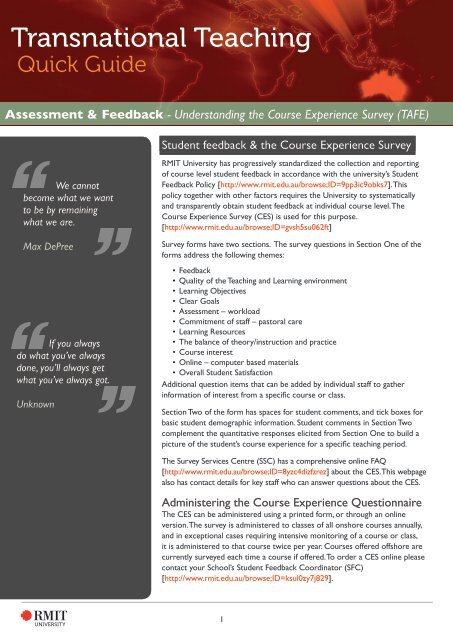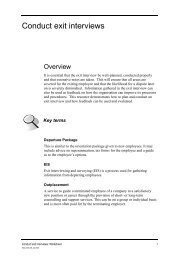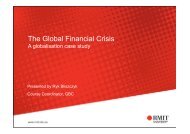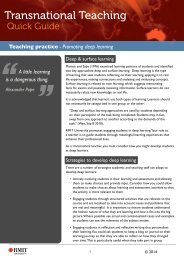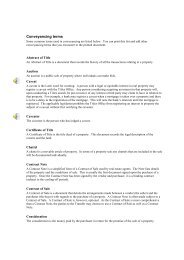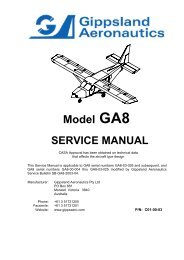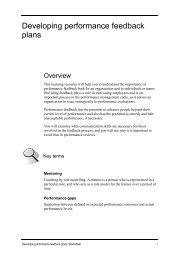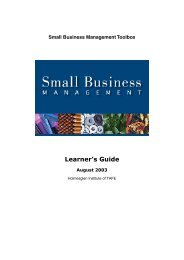Understanding the Course Experience Survey ... - RMIT University
Understanding the Course Experience Survey ... - RMIT University
Understanding the Course Experience Survey ... - RMIT University
Create successful ePaper yourself
Turn your PDF publications into a flip-book with our unique Google optimized e-Paper software.
Transnational Teaching<br />
Quick Guide<br />
Assessment & Feedback - <strong>Understanding</strong> <strong>the</strong> <strong>Course</strong> <strong>Experience</strong> <strong>Survey</strong> (TAFE)<br />
Student feedback & <strong>the</strong> <strong>Course</strong> <strong>Experience</strong> <strong>Survey</strong><br />
We cannot<br />
become what we want<br />
to be by remaining<br />
what we are.<br />
Max DePree<br />
If you always<br />
do what you’ve always<br />
done, you’ll always get<br />
what you’ve always got.<br />
Unknown<br />
<strong>RMIT</strong> <strong>University</strong> has progressively standardized <strong>the</strong> collection and reporting<br />
of course level student feedback in accordance with <strong>the</strong> university’s Student<br />
Feedback Policy [http://www.rmit.edu.au/browse;ID=9pp3ic9obks7]. This<br />
policy toge<strong>the</strong>r with o<strong>the</strong>r factors requires <strong>the</strong> <strong>University</strong> to systematically<br />
and transparently obtain student feedback at individual course level. The<br />
<strong>Course</strong> <strong>Experience</strong> <strong>Survey</strong> (CES) is used for this purpose.<br />
[http://www.rmit.edu.au/browse;ID=gvsh5su062ft]<br />
<strong>Survey</strong> forms have two sections. The survey questions in Section One of <strong>the</strong><br />
forms address <strong>the</strong> following <strong>the</strong>mes:<br />
• Feedback<br />
• Quality of <strong>the</strong> Teaching and Learning environment<br />
• Learning Objectives<br />
• Clear Goals<br />
• Assessment – workload<br />
• Commitment of staff – pastoral care<br />
• Learning Resources<br />
• The balance of <strong>the</strong>ory/instruction and practice<br />
• <strong>Course</strong> interest<br />
• Online – computer based materials<br />
• Overall Student Satisfaction<br />
Additional question items that can be added by individual staff to ga<strong>the</strong>r<br />
information of interest from a specific course or class.<br />
Section Two of <strong>the</strong> form has spaces for student comments, and tick boxes for<br />
basic student demographic information. Student comments in Section Two<br />
complement <strong>the</strong> quantitative responses elicited from Section One to build a<br />
picture of <strong>the</strong> student’s course experience for a specific teaching period.<br />
The <strong>Survey</strong> Services Centre (SSC) has a comprehensive online FAQ<br />
[http://www.rmit.edu.au/browse;ID=8yzc4dizfzrez] about <strong>the</strong> CES. This webpage<br />
also has contact details for key staff who can answer questions about <strong>the</strong> CES.<br />
Administering <strong>the</strong> <strong>Course</strong> <strong>Experience</strong> Questionnaire<br />
The CES can be administered using a printed form, or through an online<br />
version. The survey is administered to classes of all onshore courses annually,<br />
and in exceptional cases requiring intensive monitoring of a course or class,<br />
it is administered to that course twice per year. <strong>Course</strong>s offered offshore are<br />
currently surveyed each time a course if offered. To order a CES online please<br />
contact your School’s Student Feedback Coordinator (SFC)<br />
[http://www.rmit.edu.au/browse;ID=ksul0zy7j829].<br />
1
The SSC delivers <strong>the</strong> right number of surveys for each course to <strong>the</strong> School<br />
Feedback Coordinators in Week 6 of each semester or at a similar time for<br />
o<strong>the</strong>r teaching periods. Teaching staff decide when students complete <strong>the</strong> form<br />
in <strong>the</strong> class.<br />
<strong>Understanding</strong> <strong>the</strong> results<br />
The Head of <strong>the</strong> School reveives a document summarising <strong>the</strong> results for each<br />
set of survey forms processed by <strong>the</strong> <strong>RMIT</strong> <strong>Survey</strong> Services Centre. Information<br />
at <strong>the</strong> top of page one includes staff name and course code and name.<br />
Useful demographic details on <strong>the</strong> cohort surveyed include age distribution,<br />
distribution of number of hours per week studied in <strong>the</strong> course, and <strong>the</strong><br />
numbers of fulltime / part time and local / international students. These details<br />
provide background information against which to interpret <strong>the</strong> later results.<br />
The most important piece of data in this top section is <strong>the</strong> number of surveys<br />
completed. Staff may wish to calculate a percentage response rate to use alongside<br />
<strong>the</strong> total number of survey responses when considering <strong>the</strong> survey results.<br />
The second part of page one gives a summary of responses to <strong>the</strong> survey<br />
items. The survey comprises 13 items with responses coded from 1 = ‘strongly<br />
disagree’ to 5 = ‘strongly agree’. All items are worded positively, so that higher<br />
scores indicate greater student satisfaction. The summary graph shows <strong>the</strong><br />
percentage of respondents who answered in <strong>the</strong> top two categories (‘agree’ or<br />
‘strongly agree’) for each item. Note that <strong>the</strong> scale displayed for <strong>the</strong>se graphs<br />
varies according to <strong>the</strong> highest percentage achieved. Anyone scanning a number<br />
of <strong>the</strong>se summary documents should be careful to take note of <strong>the</strong> scale used.<br />
As a general rule, any item achieving less than 50% agreement should give cause<br />
for reflection.<br />
The final piece of information on <strong>the</strong> summary page is <strong>the</strong> Good Teaching Scale<br />
score, comprising items 2, 3, 6, 8, 9 and 10. This gives an overall indication of<br />
student satisfaction, and is <strong>the</strong> same scale used in program surveys including<br />
Student <strong>Experience</strong> <strong>Survey</strong>s.<br />
The remaining pages of <strong>the</strong> document give <strong>the</strong> results for individual items,<br />
including <strong>the</strong> additional items that may have been included by <strong>the</strong> teacher. These<br />
must obviously be examined with <strong>the</strong> additional information of <strong>the</strong> wording of<br />
<strong>the</strong> items as provided separately to <strong>the</strong> students. Each individual item has a bar<br />
graph showing <strong>the</strong> response distribution toge<strong>the</strong>r with a mean score based on<br />
<strong>the</strong> numerical values given to <strong>the</strong> responses. A mean of 4 or higher indicates a<br />
positive student response (an ‘average’ in <strong>the</strong> ‘agree’ to ‘strongly agree’ range).<br />
1 2<br />
(Strongly disagree)<br />
Staff reflecting on <strong>the</strong>ir feedback results should first consider <strong>the</strong> overall Good<br />
Teaching Scale score, and <strong>the</strong>n look at responses to individual items. Consistently<br />
low percentage agree scores or mean response scores in items grouped<br />
under a particular <strong>the</strong>me can indicate a need to focus on strategies for improvement<br />
in that area.<br />
<strong>Course</strong> teams can also make comparisons with program and School aggregated<br />
data on <strong>the</strong> <strong>Survey</strong> Services Centre site – though this is not available until all<br />
course surveys are processed, usually after semester assessment cutoff dates.<br />
The items in <strong>the</strong> <strong>Course</strong> <strong>Experience</strong> <strong>Survey</strong> can be classified into <strong>the</strong>mes.<br />
These are listed below, toge<strong>the</strong>r with some suggestions for staff to consider<br />
when formulating <strong>the</strong>ir response to <strong>the</strong> student feedback.<br />
2<br />
©
Interpreting & informing practice – Technical &<br />
Fur<strong>the</strong>r Education (TAFE)<br />
Teaching style – Organisation<br />
1. The learning objectives in this course are clear to me<br />
2. My instructors have a thorough knowledge of <strong>the</strong> course assessment<br />
Do you:<br />
• Understand <strong>the</strong> competencies and performance criteria from <strong>the</strong> Training<br />
Package competencies relevant to your course<br />
• Incorporate <strong>the</strong>se competencies and performance criteria into your<br />
learning objectives and outcomes<br />
• Clearly articulate <strong>the</strong> relationship between course content, learning and<br />
teaching resources, key competencies and relevant training packages<br />
• Align learning objectives, learning outcomes, and assessment Do you<br />
evaluate this alignment For example, do you know if <strong>the</strong>re are gaps in<br />
it Do you assess what you teach Does your content contribute to <strong>the</strong><br />
stated objectives of <strong>the</strong> course<br />
Teaching style – Delivery<br />
3. My instructors provide opportunities to ask questions<br />
6. My instructors treat me with respect<br />
9. My instructors communicate <strong>the</strong> course content effectively<br />
10. My instructors make <strong>the</strong> course as interesting as possible<br />
Do you:<br />
• Chunk your lecture into coherent sections Introduce each section with<br />
an overview and explanation of where it fits with what has gone before<br />
Summarise key points of each section at <strong>the</strong> end<br />
• Engage <strong>the</strong> students by seeking informal feedback at intermediate points<br />
in <strong>the</strong> class<br />
• Use relevant examples of concepts (from current events, popular culture,<br />
etc) so students can connect to <strong>the</strong> content<br />
• Value-add to what is in <strong>the</strong> textbook How do you do this<br />
• Think about how <strong>the</strong> students engage with your material – do <strong>the</strong>y just<br />
sit and listenAre <strong>the</strong>re opportunities through <strong>the</strong> lecture for students to<br />
make active responses<br />
• Provide work related examples to your students so that <strong>the</strong>y may make<br />
<strong>the</strong> link between <strong>the</strong>ory and practice.<br />
• Organise guest speakers to give a lecture in your course which may add<br />
value to <strong>the</strong> content How often do you invite a guest speaker<br />
• Use student centred teaching styles Do you know on a weekly basis<br />
where your students are in relation to <strong>the</strong> learning outcomes of <strong>the</strong><br />
course Do you use micro evaluation techniques, such as asking your<br />
students on a regular basis: “What is <strong>the</strong> key thing you have learnt today”,<br />
“What was <strong>the</strong> key thing you learnt in <strong>the</strong> last session”<br />
3<br />
©
Assessment & feedback<br />
4. Assessment tasks in this course require me to demonstrate what I am<br />
learning<br />
5. The amount of work required in this course is about right<br />
8. My instructors understand my learning needs<br />
Do you:<br />
• Look at <strong>the</strong> teaching and assessment schedule. Are <strong>the</strong> assessment tasks<br />
evenly placed through <strong>the</strong> semester Is <strong>the</strong>re sufficient time between<br />
introducing a concept and assessing it Is <strong>the</strong> student workload spread<br />
fairly through <strong>the</strong> semester (within and between courses/programs in<br />
your School)<br />
• Provide opportunities for regular formal and informal feedback<br />
throughout <strong>the</strong> semester<br />
• Align <strong>the</strong> competencies required for <strong>the</strong> training package under study with<br />
appropriate learning objectives, learning outcomes and assessment<br />
• Do you evaluate <strong>the</strong> above alignment If yes, how<br />
• Use strategies for providing bulk feedback. For example, using technology<br />
(eg Blackboard) to give common comments on assessment deficiencies,<br />
common problems or issues<br />
• Provide a mark sheet to return with assignments which lists <strong>the</strong><br />
assessment criteria, competency criteria, and training package criteria so<br />
students can see <strong>the</strong>ir performance against each criterion and how <strong>the</strong><br />
overall mark was awarded<br />
• Provide model answers, peer review and/or peer assessment<br />
opportunities Do you know how to provide <strong>the</strong>se opportunities in ways<br />
that benefit you and <strong>the</strong> learner<br />
• Cross course assess<br />
• Explain written feedback with students upon request<br />
• Use specific strategies with students from non English speaking<br />
background or students with comprehension and learning difficulties<br />
• Use, or are you aware of, contemporary teaching and learning assessment/<br />
plagiarism support packages such as Turnitin<br />
Competencies & workplace readiness<br />
11. I can see how this course will help me in <strong>the</strong> workplace<br />
12. This course perpares me for working in a global and international setting<br />
Do you:<br />
• Use real life examples from <strong>the</strong> workplace in your lectures<br />
• Do you relate <strong>the</strong> content of your course to a particular training package<br />
and/or competencies Do you relate your content to o<strong>the</strong>r courses in <strong>the</strong><br />
program as appropriate<br />
• Evaluate your students’ recognition of <strong>the</strong> alignment between your course<br />
content, competency based teaching requirements, and particular training<br />
packages If yes, how<br />
4<br />
©
Resources & facilities<br />
7. The web based (online) materials for this course are effective in assisting my<br />
learning<br />
Do you:<br />
• Check your slides for accuracy and readability<br />
• Up date your readings regularly Are your content and teaching tools<br />
relevant to your students’ experiences Are <strong>the</strong>y relevant to particular<br />
competencies and training packages that inform your course Are <strong>the</strong>y up<br />
to date Do you look for new readings each year<br />
• Is your Blackboard site maintained regularly Do you know where to go<br />
to receive Blackboard training<br />
• Direct students to relevant external websites<br />
• Know how to make full use of <strong>the</strong> technology that is available to you in<br />
<strong>the</strong> classrooms<br />
• Actively direct students to library and learning support resources as<br />
appropriate<br />
• Use mobile leaning techniques to support your teaching style and student<br />
learning For example, podcasts of key course concepts that students find<br />
difficult to grasp; Blogs to receive student information and to offer online<br />
feedback<br />
• Present your content around a small number, no more than three, key<br />
concepts that are crucial to <strong>the</strong> course, and/or that previous student<br />
evaluations/assessments have highlighted as problematic areas of student<br />
learning<br />
• Use <strong>the</strong> online learning and teaching support services that are available to<br />
ALL academic staff<br />
Useful resources<br />
Support is available from your Deputy Head of School (Learning & Teaching) or<br />
equivalent. Your College Academic Development Group or learning & teaching<br />
specialist can also provide advice, support and professional development.<br />
The CES results may highlight areas for streng<strong>the</strong>ning your teaching practice.<br />
There are a number of resources available to assist you with interpreting your<br />
CES results, including:<br />
• The CES Analysis Project:<br />
http://www.rmit.edu.au/browse;ID=v9evqzzu8k3n<br />
5<br />
©


